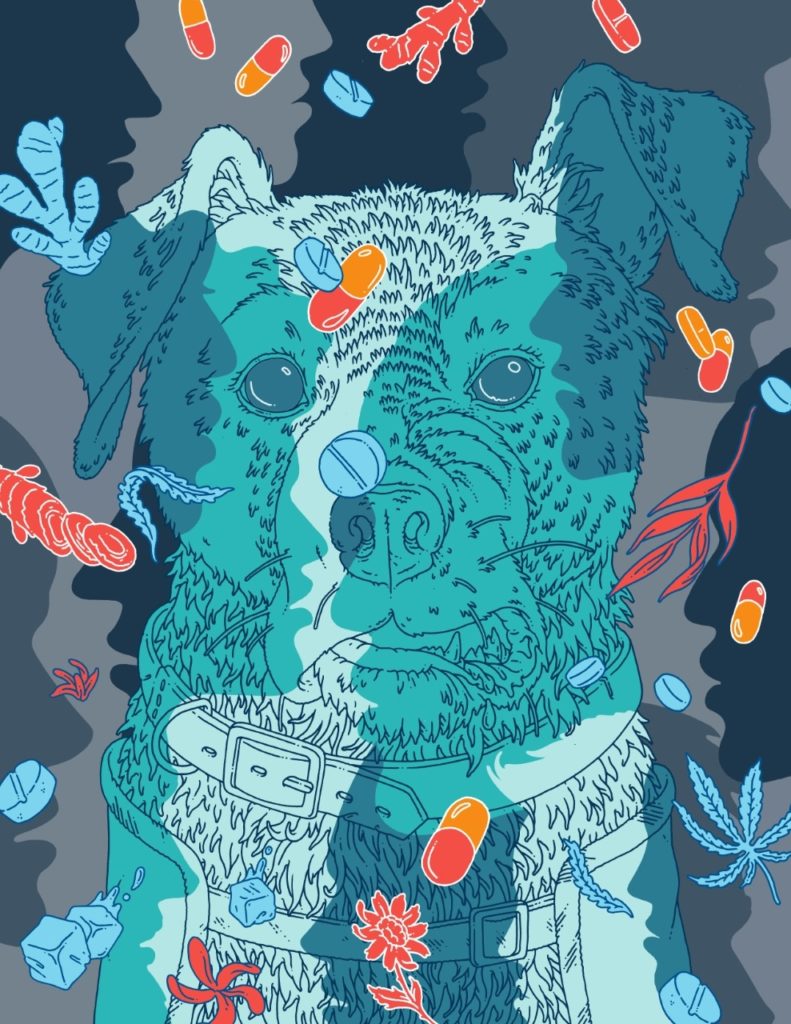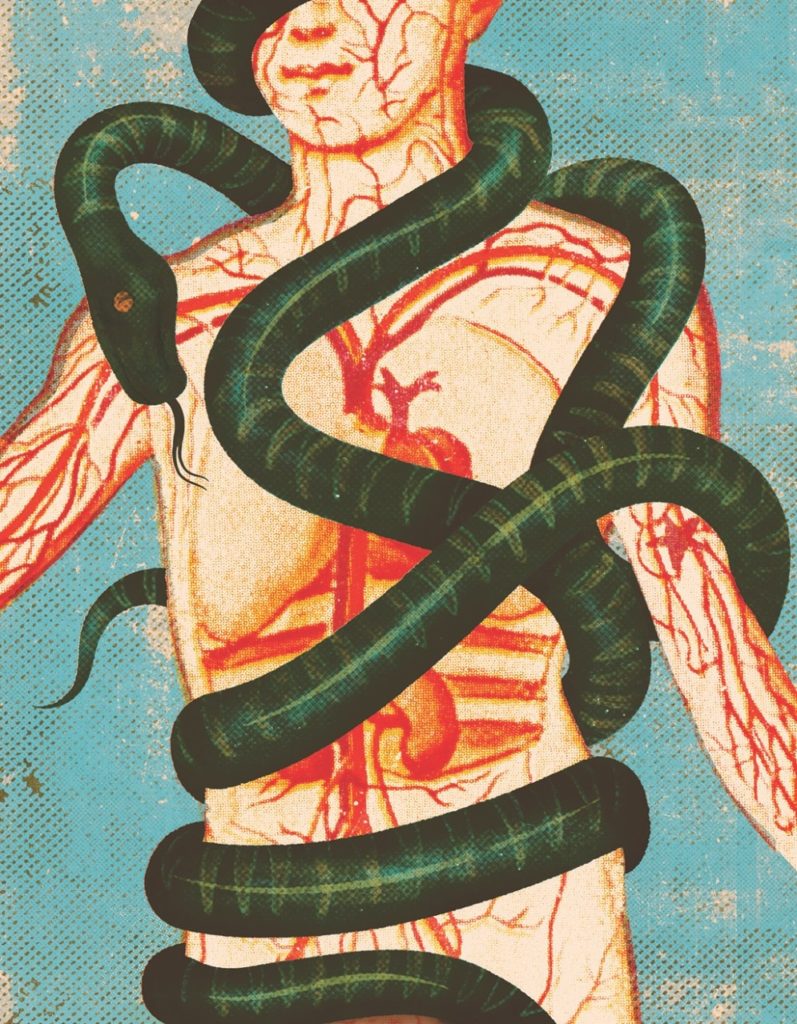Reforming pain
Goodbye to one-size-fits-all solutions to rein in pain

The paradox of pain is that “it is so good, precisely because it is so terrible,” said Sean Mackey, MD, PhD, who leads Stanford’s division of pain medicine. Any less terrible and we’d ignore it — potentially to our mortal detriment. Healthy pain is like a service dog guiding us through a world full of perils.
For a growing number of Americans, however, that faithful dog has gone rabid and broken from its leash. According to a 2018 Morbidity and Mortality Weekly Report paper, co-authored by Mackey, about 1 in 5 U.S. adults suffer from chronic pain, with an even higher prevalence among women, people living in poverty, rural residents, older people and people with public health insurance.
A World Health Organization study found a four-times-higher incidence of depression or anxiety among people living with chronic pain, which often interferes with the ability to concentrate, eat and sleep. And the effects of that pain on quality of life — for the primary sufferers but also the people around them — radiate out, touching nearly everyone, said Mackey.
The economic impact of chronic pain is also astounding, resulting in $560 billion to $635 billion in direct medical costs and lost productivity, according to the MMWR paper.
Traditional treatments don’t work for many sufferers, said Mackey, and they can have negative consequences; the most obvious example of treatments gone awry is the misuse of the mightiest and most notorious class of painkiller, opioids, which has fed a devastating nationwide epidemic of addiction and overdoses.
In part a corrective reaction to the one-size-fits-all opioid prescription crisis that is causing so much suffering, a profound shift is underway in how some Stanford Medicine scientists are studying and clinicians are treating chronic pain.
“The word ‘pain’ does not refer to one kind of thing we can — or should even try to — turn off with a single drug,” said pain medicine specialist Vivianne Tawfik, MD, PhD, associate professor of anesthesiology, perioperative and pain medicine, who is one of 28 physicians practicing in the Pain Management Center at Stanford Health Care. “Pain is hundreds of different things. And we’ve learned that that’s how we must treat it.”
The new approach, said Mackey, who leads the pain center and holds the Redlich Professorship, is to personalize pain treatments — “to fill our clinical buckets with the best tools we can make or find and then zero in on the best combination of them to use to help each individual patient for their unique pain problem.”
Mackey was co-chair of the committee that produced the National Pain Strategy, a 2016 report funded by the National Institutes of Health, recommending a multi-modal approach to improving the assessment and care of people in pain. Mackey also was co-author of a recent Stanford-Lancet Commission report calling for sweeping reforms in response to the opioid crisis.
Pain research and treatment at Stanford Medicine ranges from the molecular to the psychological. One group of researchers seeks to hack the nervous system’s pain networks with molecular compounds that more safely and subtly adjust the gain on pain. Another is experimenting with the mushroom-derived psychedelic drug psilocybin to forge new, more tolerable relationships to the pain they can’t get to go away.
And another educates patients through online instructional sessions about the physiological and psychological aspects of pain and how to manage it. Finally, a major NIH-supported effort aims to find biomarkers for pain and identify which patients will respond to which treatments.
What is chronic pain?
The International Association for the Study of Pain defines pain as an unpleasant sensory and emotional experience associated with or resembling actual or potential tissue damage. Pain that persists or recurs for longer than three months is considered chronic.
If pain is an alarm announcing injury or its threat, chronic pain is an alarm that won’t turn off, even if no injury or threat remains. In such cases, pain becomes its own pathology, not an indication of another.
The depression, anxiety and sleep disorders that can result can make the pain worse, laying down a neural circuit of suffering that can get more and more difficult to interrupt. Chronic pain is also associated with many other disorders including cardiovascular and sexual ones. It is also tied to a higher-than-normal rate of suicide.
When you step on a tack, a kind of cell called a nociceptor detects the damage and sends a signal up your leg to your spinal cord, where it connects to another long nerve cell that takes it to the part of your brain called the thalamus, where it is perceived and then sent to the cortex, where it finally turns into suffering. “Ouch,” you say, moving your foot off the tack.
Almost immediately, your brain sends signals back toward the injury: “Message received, turn off the alarm and calm everyone down.” Pain-quelling chemicals are released along the entire path to do just that. If you’ve put a hole in your foot, the acute stab of pain will transition to a slower, lower-level ache that will diminish and fade as the wound heals.
If that injury is repeated, however, other pain signals may head brainward, where they are first perceived and then experienced as suffering. Long-lasting or repeated injuries or serious infections can cause chronic pain, and sometimes, even after an injury has healed, errant alarm signals continue to alert the brain about tissue damage that no longer exists.
The science of making pain stop
Opioids are a powerful if blunt pain intervention. They turn off pain by interrupting the pain signals being sent to the brain. When you take morphine, the opioid molecules enter your bloodstream and spread around your body, fitting into little locked switches on the outsides of cells. These switches, proteins called receptors, unlock and turn on or off when they receive molecules of just the right shape and size to bind to their active site.
In the case of receptors that activate or inhibit nociceptors, they either send pain signals to the brain or keep those signals from being sent. The shape of the molecule that binds to the receptor defines the medicine. Molecules that fit into the main class of pain receptors, opiate receptors, are opioids.
The Holy Grail of pain treatment has long been a compound that fits into opiate receptors to turn off pain, without causing adverse side effects. The problem with opioids, of course, is that those same opiate receptors, in addition to turning off pain, can also send signals to stop breathing. Opioids also are addictive. That is a deadly combination responsible for more than 100,000 U.S. deaths each year.
More than a decade ago, Nobel Prize-winning work by Stanford Medicine physiologist Brian Kobilka, MD, made possible the search for a more targeted opioid painkiller, one that would quell pain without stopping breathing or causing addiction.
Kobilka, who’s the Hélène Irwin Fagan Chair of Cardiology, and Nobel co-recipient Robert Lefkowitz, MD, were the first to describe in detail the large class of membrane receptor proteins known as G-protein-coupled receptors, which include opiate receptors. These receptor proteins receive messages on the outer surface of a cell that set off actions inside of it. They are the interface where cells receive most of their instructions, including the command to turn off pain.
The immense complexity of receptors and the molecules that unlock them has so far frustrated scientists’ efforts to find a much safer yet still effective opioid. But, aided by new laboratory techniques, Kobilka is hotly pursuing an approach that would amplify and fine-tune the body’s own painkilling mechanisms.

Retuning the brain’s pain circuitry
Kobilka’s strategy is to discover a drug that adjusts the receptor protein’s sensitivity to the body’s naturally produced opioids. This is not how classic painkillers work. Instead, they usually mimic the body’s natural opioids, binding to the receptor’s active site. Kobilka is seeking molecules that bind to another location on the same protein and remotely influence the active site’s behavior.
This strategy, which is also being used by others, might sound indirect, but it makes sense when you think about how receptor proteins function. Proteins are masses of atoms that flex, twist and wiggle in response to their environment, and the binding of molecules anywhere on the protein’s surface can trigger a change in the protein’s shape and influence the sensitivity of an active site.
In drug discovery lingo, the active site is known as the orthosteric target, and a binding site that influences the orthosteric site is an allosteric target. Opioid drugs have traditionally targeted the obvious location: the receptor protein’s orthosteric site. But Kobilka is shooting for an allosteric site.
“A megaphone is a pretty good analogy for the allosteric site,” said Kobilka. “The source of sound — the voice in this analogy — comes from the orthosteric site. But if there is a voice, it can be modulated — turned up — by the allosteric site.”
Kobilka wants to find an orthosteric binding site that can be activated only by the body’s own endogenous opiates, so he can then target an associated allosteric site and amplify that already present pain suppression. Such a drug could be both more nuanced in the physiological changes it targets and also have a kind of built-in anti-abuse security system.
“If a person doesn’t have a release of endogenous opiates as a response to their own pain,” said Kobilka, “then the allosteric modulator won’t do anything. If you aren’t in pain, taking the drug would be like turning a megaphone up but with no sound to amplify.”
New technology is allowing Kobilka and his colleagues to quickly search libraries of up to a trillion compounds for molecules that bind with specific allosteric sites in promising ways. “These new libraries significantly broaden the chemical space we can search, making it much more likely that we will find something effective and safe,” he said.
Studying cannabinoids for more types of pain
In addition to hunting for precisely shaped painkilling molecules to engage opiate receptors in more targeted ways, Kobilka and his team are looking for molecules that engage another class of pain receptors altogether: cannabinoid receptors.
Like opioid receptors, cannabinoid receptors are a class of G-protein-coupled receptors that, among other things, are involved in the experience of pain. Kobilka is collaborating with Tawfik and others on a cannabinoid-receptor-focused project funded by the Defense Advanced Research Projects Agency.
“Brian is 1,000% receptor-focused,” said Tawfik. “His brilliance is looking at the structure of a receptor and being able to target compounds to that receptor in a way that engages it and causes the activation of different downstream pathways. … Then, once he’s found interesting and promising ones, I see if they work in mice.”
Another reflection of the shift toward making more targeted, personalized drugs is the fact that Tawfik has expanded the number of pain models she uses for her research compared to just a couple of years ago.
“Now, if a drug doesn’t work on one model, I see it not as a fail but as a promising sign that it might be targeted enough to be of real value for another pain condition.”
Then, she and her team were focused on one model, for complex regional pain syndrome, a debilitating chronic nerve condition she specializes in treating. But they now have a half dozen different models for different kinds of pain, she said.
“For a long time, we were looking for the panacea; a compound that would just cure pain, period! So, we wanted it to work in every mouse model for every kind of pain. But that’s exactly where we got into trouble,” she said. “Now, if a drug doesn’t work on one model, I see it not as a fail but as a promising sign that it might be targeted enough to be of real value for another pain condition.”
Tawfik would rather be able to prescribe a drug for a patient with inflammatory pain, say, that addresses only inflammatory pain and nothing else. “You don’t want to turn all pain off, you just want to adjust that one disabling pain,” she said.
Developing a multipronged approach
By definition, chronic pain is persistent, which is why Mackey says it is best addressed on multiple fronts at once. “If Brian Kobilka finds a nonaddictive non-respiratory-depressing opioid, that would be an incredibly important tool,” said Mackey. “But would it cure pain? Absolutely not!”
“Today, pharmacology is just a small part of what we do,” said Mackey. “Our pain center also employs psychological approaches, physical and occupational therapy, complementary and alternative medicine, and patient empowerment or educational approaches.”
Researchers are taking many tacks as well.
A Stanford Medicine researcher honing an educational approach is pain scientist and psychologist Beth Darnall, PhD: After years of teaching multisession pain management classes that have been studied for decades, she has compressed key elements of the classes and combined them with other material into a widely accessible two-hour class.
The intervention, called Empowered Relief, gives people with acute and chronic pain neuroscience education, mindfulness-based principles and some cognitive behavioral therapy-based skills to better manage their pain and related symptoms, said Darnall, a professor of anesthesiology, perioperative and pain medicine and director of the Stanford Pain Relief Innovations Lab.
The program launched in 2013 and in 2019 was disseminated to people with acute and chronic pain in 16 countries and in seven languages.
“Most of the 100-million-plus people in the U.S. living with pain don’t have easy access to surgery or carefully managed pain medications or an eight-session cognitive behavioral therapy to gain pain management skills,” she said, noting that Empowered Relief expands access to pain care, and it can work alongside other treatments.
The course is offered free by some health care providers (including Stanford Health Care), and certified instructors are listed online at stan.md/paincourse, said Darnall.
“Data from multiple trials show that we can help significantly reduce pain and other key outcomes with this one-time intervention,” she said.
A study published in JAMA Network last year favorably compared the effectiveness of Empowered Relief to eight-session cognitive behavioral therapy for people with chronic lower back pain. Participants in both groups showed significant reductions in “pain intensity, pain interference, sleep disturbance, anxiety, depression and pain bothersomeness,” said Darnall.
“The psychological component is an essential part of recovery from chronic pain.”
Another study published this year in Anesthesia & Analgesia showed that orthopedic trauma surgery patients who received a version of Empowered Relief had reduced pain after surgery and up to three months later. Cleveland Clinic offers Empowered Relief in its chronic pain clinic and as standard medical care for all spine surgery patients.
Research that bridges molecular and psychological approaches is also unfolding in the lab of Boris Heifets, MD, PhD, who is studying the use of psilocybin for chronic lower back pain. While some evidence indicates that psychedelics like psilocybin may have a direct analgesic effect, Heifets said, the point of his research is to see if a psilocybin trip helps some people improve their relationship to their chronic pain.
An experimenter stays with each subject through the experience, remaining nearby for the subject’s safety and peace of mind but not engaging in psychotherapy during the trip. Heifets wants to establish whether a baseline effect exists from only ingesting the drugs before adding psychotherapy to the sessions.
“The psychological component is an essential part of recovery from chronic pain,” said Heifets. “Psychedelics can catalyze psychological transformations that could take a very long time without a chemical catalyst.”
Matching patients and treatments
Whether Stanford Pain Management Center specialists employ medications or other treatment options, relieving a patient’s chronic pain depends on their ability to personalize that care.
“The difficult part is figuring out which ones will work for which patients,” said Mackey. He has been treating pain patients for decades but, he said, “even with all my experience, I can only predict which treatments will work for any given patient 30 to 40% of the time.”
One of the most effective drugs for some chronic pain patients, for example, is naltrexone, a drug initially designed to block the intoxicating effects of alcohol and drugs and to reduce cravings. Researchers believe it has an entirely different action at lower doses, reducing neural inflammation and pain.
“It is a hit-the-ball-out-of-the-park drug that is transformative for many people with chronic pain. It has almost no side effects. And it is dirt cheap,” said Mackey, who collaborated on some of the original experiments on low-dose naltrexone for chronic pain. “The problem is, I don’t know which of my patients it’s going to work for until I try them on it for a few weeks.”
But Mackey said he and his colleagues are chasing a solution to the challenge of matching chronic pain patients and therapies by developing objective biomarkers to enable a precision medicine approach for pain.
His team is deploying brain imaging technology, genetics, wearables, sensory testing, self-reporting surveys and machine learning models to predict the treatments — including medications — a person suffering from chronic pain will best respond to.
They have also created a learning health system called CHOIR that compiles high-quality data from every patient encounter. Clinicians have implemented the system at clinics at Stanford and throughout the United States.
“CHOIR allows us to characterize the unique profile of every patient in ways that help us target the right treatments and to track them over time,” he said. “Take naltrexone, for example: If instead of that 30-to-40% rate, I could select with 90-to-100% accuracy, that would make all the difference.”
Ultimately, Mackey plans to integrate the biomarker development work into CHOIR to aid clinical decision-making and improve the outcomes of patients with pain and other conditions.
“The problem is, I don’t know which of my patients it’s going to work for until I try them on it for a few weeks.”
One young female patient with a debilitating case of complex regional pain syndrome sought Mackey out after years of failing to improve under her local care in Florida.
“Using CHOIR, we could see that in addition to her pain, she’d also had terrible fatigue, poor sleep and depressed mood — an association of symptoms that all can respond to low-dose naltrexone,” said Mackey. “Once on the drug, she started sleeping better, feeling less tired and less depressed. Her pain showed dramatic improvement too.”
When she felt well and attentive enough to get some traction in pain psychology, Mackey enrolled her in Darnall’s Empowered Relief class, which further amplified the improvements. “While still not entirely pain free,” said Mackey, “she got much more energetic, focused, hopeful and able to pursue a better future.
“Now she works, has two young children and is enjoying life. It would have been hard to imagine any of that when she first came to us.”
From data to molecules to psychology, welcome to the new and improved world of chronic pain treatment.



